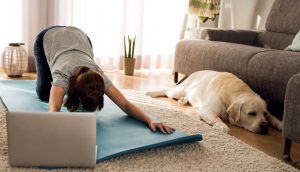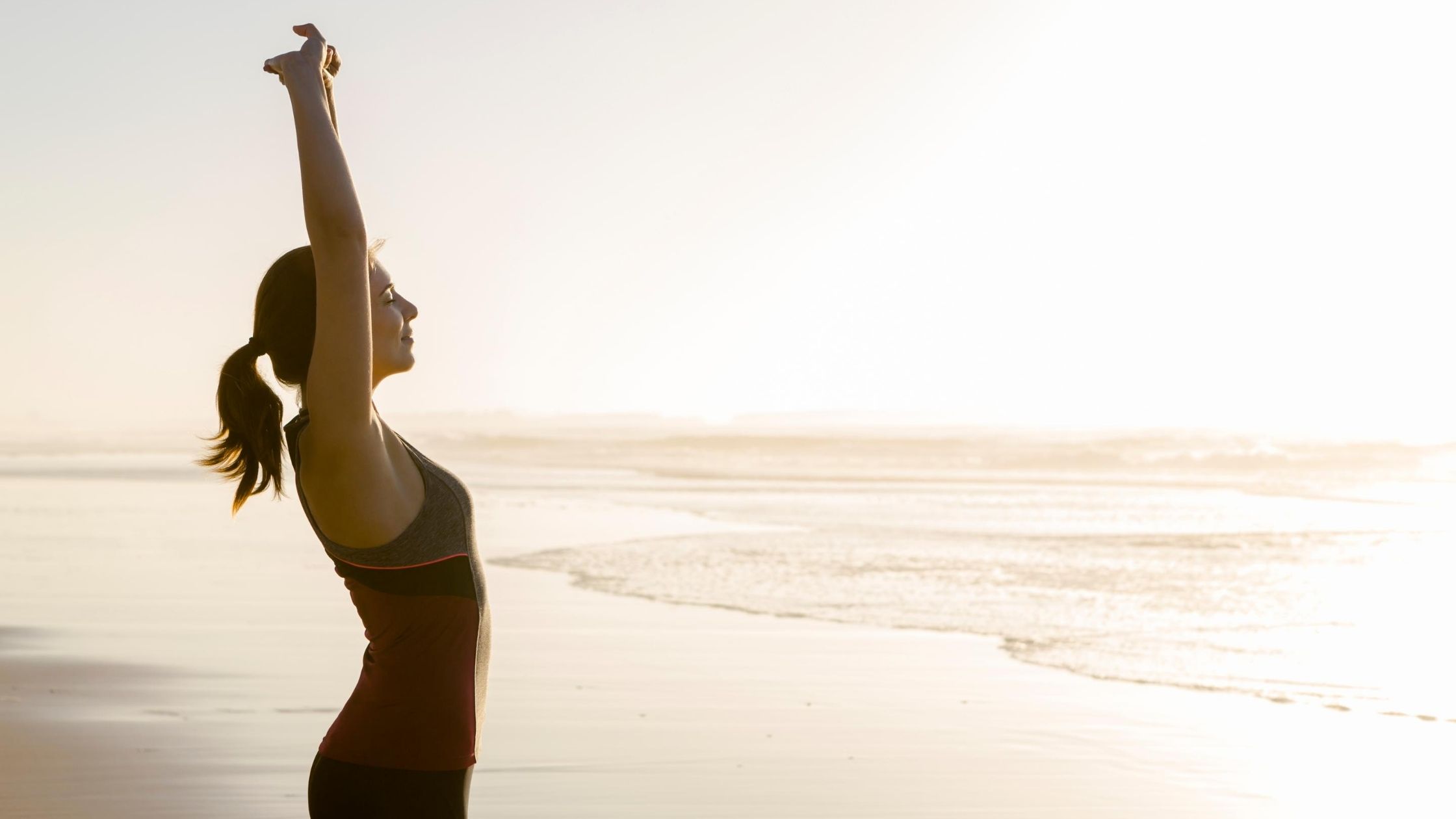“Exercise is a celebration of what your body can do…
Not a punishment for what you ate.”
-Unknown
When you think about exercise – do you automatically cringe, or do you actually look forward to it? I used to cringe when someone wanted to “work out” together, but over time I have shifted my thinking and now I look forward to exercise. It wasn’t that long ago I laughed at the idea of teaching fitness classes, but now it is one of my favorite things. I want to share how I made that shift from rolling my eyes when exercise was mentioned, to being that energetic instructor yelling “YES YOU CAN!” over the microphone while fist pumping at the front of the class.
Why Exercise is Important
First – let’s go over a few quick reminders about WHY exercise is important. As you might already know, there are numerous benefits of regular exercise: reduced weight gain, improved sleep patterns, reduced risk of noncommunicable diseases like diabetes, obesity, heart diseases, and more (Andersen & Hanrahan, 2014). Finding ways to move our body daily is not only beneficial to our physical health; it can help relieve stress too. Callaghan (2004) found that research suggested “exercise improves mental health and well-being, reduces depression and anxiety and enhances cognitive functioning.” Physical activity plays an important role in improving the immune system’s ability to function during normal circumstances and it is even more vital given the current conditions of the pandemic (Ainsworth & Li, 2020).
Because of the COVID-19 pandemic, fitness resources were disrupted so we have had to learn to adapt. Gym closures meant losing the place and equipment for structured physical activity. Group fitness classes were cancelled and personal training sessions were refunded or rescheduled. The quarantine has completely changed the fitness industry and forced us to get creative in our exercise routine. And if you are anything like me, when you have to work out from home and watch a fitness video…right next to your comfy, cozy couch…where you wonder how that last episode of the television show you were watching ended…it can make it VERY difficult to find the motivation to “press play” on your workout video!
Here are a few tips to increase your motivation and make physical activity an enjoyable part of your daily routine:
1. Start calling it “movement” or “physical activity” instead
The terms “exercise” and “workout” have started getting a negative reputation, and toxic fitness culture has led us to believe that exercise is our punishment for overindulging in our favorite foods…but what if you could stop working against your body and instead started working WITH your body? If you typically don’t look forward to exercise, then I would encourage you to start using the terms “movement” or “physical activity” when referring to moving your body in a way that promotes your health! This simple mindset shift can have some helpful effects when it comes to thinking about daily movement.
2. Set a movement reminder during work hours
If you find yourself at your desk for hours on end, try setting a reminder on your phone or desktop and move around for a bit! Setting a scheduled movement reminder every hour can be helpful to boost your energy, relieve tension, and increase your focus. Whether that is taking the dog for a quick walk around the block, having a mini-dance break with your kids, or just doing some gentle stretching it is important to get moving for a bit.
 3. Find the joy in movement!
3. Find the joy in movement!
For those of you who may be more intimidated or shy to try out group fitness classes – this is your chance! Tune into virtual or live streaming classes from your own home, and you won’t be preoccupied with worrying about what everyone else is thinking. Your daily movement doesn’t need to be a structured exercise session. You can find pockets of time throughout the day to move in ways that you enjoy. My favorite types of workout programs incorporate music so when I am doing strength or cardio moves it feels like less work and I push harder to match the rhythm! Dancing is one of my favorite forms of exercise, and oftentimes I will create an uplifting playlist to get lost in the music. Take some time to play around with different ways to move and see which ones make you feel the best and have the most fun! Finally, instead of trying to burn off those extra calories from the cookie you enjoyed with lunch, find ways that you enjoy moving your body and that creates more motivation to move!
4. Stop shaming yourself and practice more patience
Many people tend to feel guilty if you don’t go to the gym or get a workout in – which usually leads to us shaming ourselves for not doing something we know we “should” be doing. But especially while we are living through a global pandemic, this type of mindset is something that can cause you additional stress! Instead, I would like to challenge you to show yourself patience and compassion as you learn how to adapt to the “new normal” of how we are living. You may find yourself comparing where you are now to where you were before the pandemic began but show yourself some grace and kindness during this time as you learn to navigate through this uncharted territory of the COVID-19 “new normals.”
5. Some movement is better than none
Remember, physical activity doesn’t have to be an hour-long sweat fest – you can add in multiple 5 to 10-minute blocks during the day for walking, dancing, stretching, playing with your kids (or your pets), or however you find joy in movement! The American College of Sports Medicine (ACSM)’s initiative, Exercise is Medicine, recommends physical activity for promoting mental health: with a duration of 30-60 minutes of moderate to vigorous physical activity per day and a frequency of 3-5 times per week. The higher intensity of the session, the lower frequency required throughout the week. These guidelines are something to strive for but even if you move in small ways throughout the day, a little movement is going to be better than nothing!
6. Create a “Pros and Cons” list
It can be helpful to start with a prompt to help you list out the pros and cons, such as “If I were to be physically active…” and then brainstorm all of the positive things that come from it regarding your thoughts, feelings, and consequences. Then repeat that same prompt for the negative things that might come after the prompt and list them out. Your goal is to try and find more positives than negatives to help you find more motivation to incorporate physical activity into your daily life!
7. Make it social
Join a virtual fitness challenge, participate in a virtual race for a charity that you value, find a “live” virtual class through Zoom, or set up a workout video that you and your family can do together! By finding ways to increase our social connectivity, it can also help boost our mood and also provide us accountability for our movement goals.
8. Focus on how you FEEL instead of how you LOOK
Often times the goal of physical activities are based on physical appearance, strength, or body composition. A study by Hearon (2018) demonstrated the people were more likely to exercise if the goal was to improve their current mood versus focusing on long term health goals. Goals related to changes in body composition or physical health can often take weeks, months, or even years to achieve. If you set goals focused on how you are feeling, you are more likely to see the immediate beneficial effects of exercise. I would encourage you to become your own experiment and notice how you feel before and compare it to how you feel after your physical activity.
It may be difficult to begin or adjust your current fitness routine so make sure you are patient with yourself. We are all living during a time of uncertainty, but you do have control over whether or not you decide to move your body. Start by finding small blocks of time for movement, make it something that you can enjoy, and then notice those positive shifts in your mood during and after you’ve completed your physical activity. Celebrate your body and be grateful for everything that it does for you on a regular basis – and always make sure to celebrate your smallest successes along the way as you take the next steps towards improving your well-being. Pump your fists in the air and repeat after me: “I CAN DO THIS!” Now go turn up the music and let your body move in whatever way feels best for you!
RESOURCES
Ainsworth, B. E., & Li, F. (2020). Physical activity during the coronavirus disease-2019 global pandemic. Journal of sport and health science, 9(4), 291–292. https://doi.org/10.1016/j.jshs.2020.06.004
Andersen, M. B., & Hanrahan, S. J. (Eds.). (2014). Doing exercise psychology. Human Kinetics.
Callaghan, P. (2004). Exercise: A neglected intervention in mental health care? Journal of Psychiatric and Mental Health Nursing, 11, 476-483.
Hearon, B. A., Beard, C., Kopeski, L. M., Smits, J. A., Otto, M. W., & Björgvinsson, T. (2018). Attending to timely contingencies: promoting physical activity uptake among adults with serious mental illness with an exercise-for-mood vs. an exercise-for-fitness prescription. Behavioral Medicine, 44(2), 108-115.
World Health Organization-#HealthyAtHome – Physical Activity
Michigan Medicine – Importance of Physical Activity and Exercise during the COVID-19 Pandemic
Nevada Today – Physical activity is a strong benefit during COVID-19
HuffPost – Exercise is not Punishment
 Melyssa previously worked as an animal trainer before attending graduate school to pursue mental health counseling, and has volunteered as a Pet Therapy team with her dog, Buddy, over the past four years. She works with clients to identify their strengths and sets therapy goals with clients that simultaneously helps them build confidence in their abilities while challenging them to grow. She also incorporates a lifestyle and mind-body focus to help clients promote physical, mental, and emotional wellness. To learn more about Melyssa visit her full profile here.
Melyssa previously worked as an animal trainer before attending graduate school to pursue mental health counseling, and has volunteered as a Pet Therapy team with her dog, Buddy, over the past four years. She works with clients to identify their strengths and sets therapy goals with clients that simultaneously helps them build confidence in their abilities while challenging them to grow. She also incorporates a lifestyle and mind-body focus to help clients promote physical, mental, and emotional wellness. To learn more about Melyssa visit her full profile here.

Leave A Comment